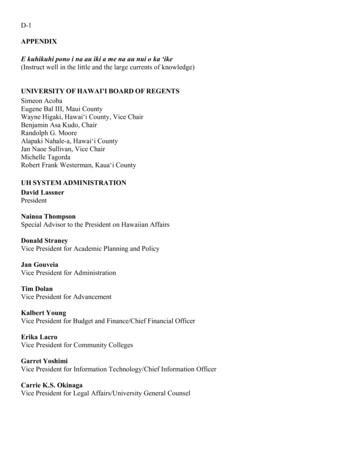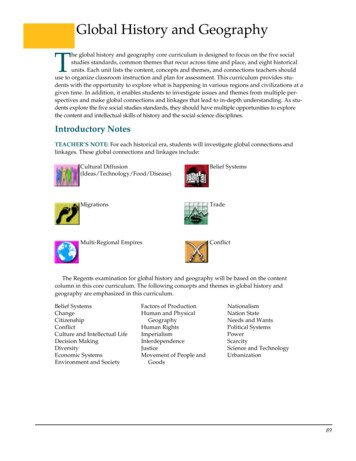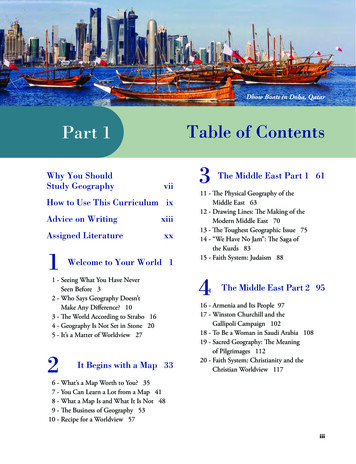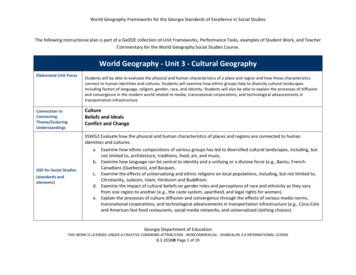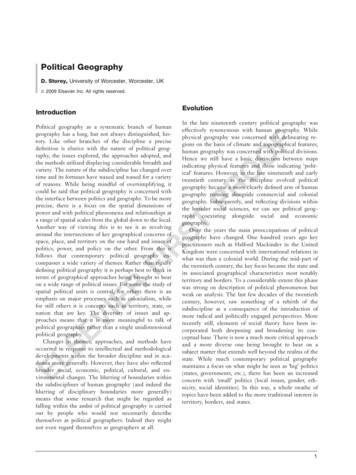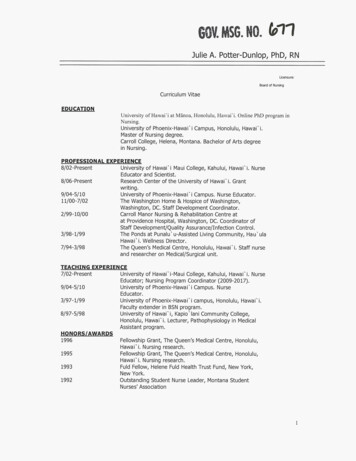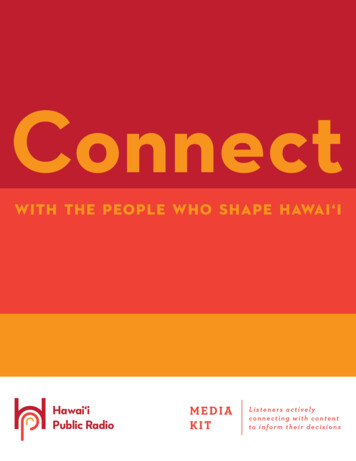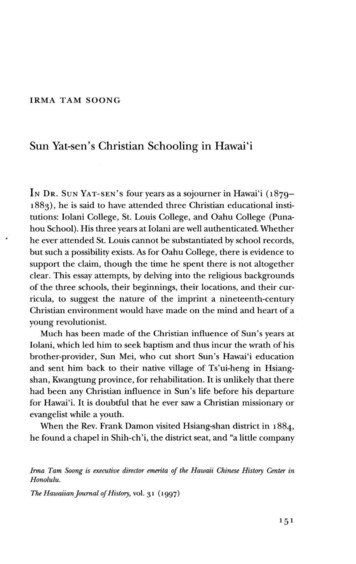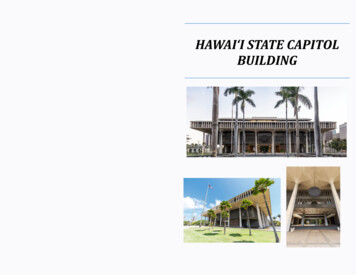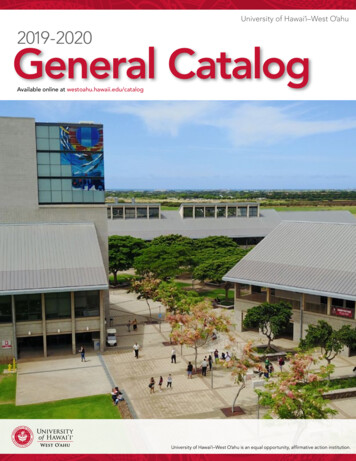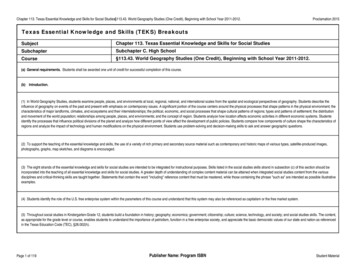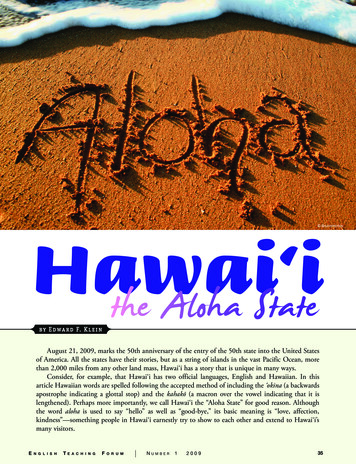
Transcription
August 21, 2009, marks the 50th anniversary of the entry of the 50th state into the United Statesof America. All the states have their stories, but as a string of islands in the vast Pacific Ocean, morethan 2,000 miles from any other land mass, Hawai‘i has a story that is unique in many ways.–Consider, for example, that Hawai‘i has two official languages, English and Hawaiian. In thisarticle Hawaiian words are spelled following the accepted method of including the ‘okina (a backwardsapostrophe indicating a glottal stop) and the kahakō (a macron over the vowel indicating that it islengthened). Perhaps more importantly, we call Hawai‘i the “Aloha State” for good reason. Althoughthe word aloha is used to say “hello” as well as “good-bye,” its basic meaning is “love, affection,kindness”—something people in Hawai‘i earnestly try to show to each other and extend to Hawai‘i’smany visitors.En g l i s hTEa c h i n gFo r u m Number1200935
The Hawaiian islands wereformed million of years agowhen lava erupted frombelow the Pacific Ocean.Today lava still spews fromthe Kilauea Volcano.—36Geography of Hawai‘i—Hawai‘i’s geological history began25 million years ago as hot lava spewedforth from an opening in the earth’s crustalmost four miles deep in the Pacific. EachHawaiian island, in its turn, grew as a newvolcano over the “Hawaiian Hotspot.” Tectonic plates gradually moved older islandstoward the northwest, allowing for the emergence of still another new island. Over time,the islands were eroded by wind, rain, andwaves. Even today, an infant pre-island,named Lō‘ihi, is building over the hotspot2009Numberand may break the ocean surface in severalthousand years.–The state stretches for 1,600 miles in anorthwest-to-southeast line. The oldest partis the Northwest Hawaiian Islands—small,uninhabited islands, atolls, and shoals. Withincredible biodiversity both above and belowsea level—plants, birds, sea mammals, turtles, fish, sea plants, and corals—this areawas proclaimed Papahānaumokuākea MarineNational Monument in 2006. Almost the sizeof California, it is the world’s largest wildlifereserve (139,000 square miles) and has beenset aside for very careful protection.1 En g l i s hTEa c h i n gFo r u m
ShutterStockToday's Museum of Scienceand Industry is the onlybuilding that remains from theWorld Columbian Expositionheld in Chicago in 1893.The better known Hawai‘i is to the southeast and consists of eight primary islands.–Ni‘ihau–The small island of Ni‘ihau (69.5 squaremiles), called “The Forbidden Isle,” is privatelyowned and was maintained as a ranch until1999. The population (only 160) now sustainsitself through subsistence farming and smallhome-based industry such as the crafting ofshell jewelry and bee keeping. Almost all theresidents are native Hawaiians, and they continue to use Hawaiian as their main language. –walls of a magnificent gorge, is often referredto as the Grand Canyon of the Pacific. Abovethe canyon are the ‘Alakai Swamp, home tomany endemic plants, birds, and insects, andbeautifully forested Kōke‘e State Park. TheNā Pali Coast is a series of valleys and cliffs ofstunning beauty that fall directly to the oceanbelow—and prevent that road from circlingthe island.–Waimea Canyon, oftenreferred to as the GrandCanyon of the Pacific, is aspectacular splash of red,yellow, and orange on theisland of Kaua‘i. –Kaua‘i–Kaua‘i (552.3 square miles), called “TheGarden Isle” because of its lushness, is theoldest of the main islands. The population(60,747) lives in towns along the highwaythat almost, but not quite, circles the island.Mount Wai‘ale‘ale (5148 ft.) dominates thecenter of the island. The summit is said to bethe second wettest spot in the world with anannual rainfall of about 460 inches.–Kaua‘i is home to some breathtakinggeography. Waimea Canyon, a spectacularsplash of red, yellow, and orange along theEn g l i s hTEa c h i n gFo r u m Number1200937
Honolulu, the state capital,stretches along the southshore of O‘ahu with itslandmark volcanic crater,Diamond Head, in thebackground on the left.–38O‘ahu–Moloka‘i–O‘ahu (600 square miles) is called “TheGathering Place,” and with a population of902,704 it is home to about 80 percent ofthe state’s population. O‘ahu encompassesthe County and City of Honolulu, the state’scapital. Two mountain ranges, the Wai‘anaeon the west (the highest point, Mount Ka‘alaat 4,025 ft.) and the Ko‘olau on the east (thehighest point, Mount Kōnāhuanui at 3,150ft.) are remnants of volcanoes. The island isalso dotted with several smaller craters, calledspatter cones, including Diamond Head, themost identifiable landmark of O‘ahu. Mostpeople live along the south shore in urbanHonolulu. World famous Pearl Harbor is alsosituated along the south shore.–Moloka‘i, (260 square miles) is called“The Friendly Isle” and has a populationof 7,404. From the northern coast juts thepeninsula of Kalaupapa, site of a former lepercolony. The sea cliffs sheltering Kalaupapa aresome of the highest in the world. Mountainson the eastern side of the island rise to nearly5,000 feet with deeply cut valleys, but thewestern side is dry and windblown. Moloka‘iremains very rural and protective of the quietlifestyle of old Hawai‘i.–2009NumberLāna‘i–Lāna‘i, “The Private Island,” is 140 squaremiles with a population of 3,164. It is a small,1 En g l i s hTEa c h i n gFo r u m
relatively dry island (with an annual rainfallof about 37 inches) that rises from the sea toa grassy, somewhat level plain where the onlytown, Lāna‘i City, and the airport are located.The island was formed by a single volcanothat last erupted perhaps 1.3 million yearsago. Although for years Lāna‘i was known asthe world’s largest pineapple plantation, inthe 1990s the economy was completely transformed to luxury tourism. –Maui–Maui, “The Valley Isle,” is the secondlargest of the Hawaiian Islands (728 squaremiles) and has a population of 135,734. Itwas formed by two volcanoes, the smaller inthe West Maui Mountains 1.3 million yearsago and the much larger dormant volcano ofHaleakalā about 750,000 years ago. Locatedon the isthmus between the two mountainsare important agricultural lands and the twolargest towns of Wailuku and Kahului.–En g l i s hTEa c h i n gFo r u m Kaho‘olawe–In the lee of Haleakalā lies the arid islandof Kaho‘olawe (just 45 miles square and presently uninhabited). It was inhabited beforeWestern contact and later used as a penalcolony and for grazing cattle and sheep. Withthe loss of most vegetation, the island lost itstopsoil and so was abandoned. The U.S. government used it for bombing practice from1942 until 1990. Since then, slow progresshas been made to remove dangerous unexploded ordnance and to reforest the island.–Hawai‘i–The Big Island of Hawai‘i (4,028 squaremiles) is also known as “The Orchid Isle” andis home to a population of 158,423. As theyoungest island, it is more than twice the sizeof all the other Hawaiian islands put together.The oldest of its five volcanoes is “only”430,000 years old. The youngest, Kīlauea,Number12009Maui’s dormant volcano,Haleakalā, is a favoritedestination of tourists. Manygather at the summit of thevolcano to watch the sunrise. –39
The Big Island of Hawai‘i,more than twice the size ofall other Hawaiian islandsput together, has fewprotective reefs and thusfew good beaches.–is the most active volcano in the world andcontinues even today to erupt and create newland. Mauna Kea and Mauna Loa are both over13,000 feet above sea level, but measured fromthe floor of the ocean, Mauna Kea is actuallytaller than Mount Everest. Both mountains areoften covered with snow in the Hawaiian “winter.” As a “young” island, Hawai‘i has few protective reefs and therefore few good beaches. Inaddition, the Big Island is prone to earthquakesbecause of its proximity to the hotspot and thegeneral instability of the tectonic plates.–402009NumberClimate–Hawai‘i’s geography explains much aboutits wonderful weather. The islands lie north ofthe equator but straddle the Tropic of Cancer.Thus, Hawai‘i is pleasantly warm year-roundbut not stiflingly hot or humid. About 90 percent of the time, the trade winds blow fromthe northeast, keeping the Islands comfortableand often bringing gentle showers. The otherten percent of the time the winds may shift,bringing humid weather with harder rain.1 En g l i s hTEa c h i n gFo r u m
At sea level, average temperatures varyonly 9ºF from the coolest month to the warmest month. In towns near the shore, the temperature rarely goes above 89ºF on the hottestsummer day nor below 57ºF on the coldestwinter night. However, the temperature dropsabout 3.6ºF per 1,000 feet of elevation. Thus,from the beach to the top of a tall mountain,there occur many “life zones,” which differnot only in temperature but also in rainfall,humidity, fauna, and flora. A dry zone at sealevel gives way to lush rainforest on the lowerslopes and to an alpine bog still higher andfinally to an almost desert-like alpine zone onthe summit.–A Brief History of Hawai‘i–Human history in Hawai‘i may havebegun with two migrations of Polynesianvoyagers from islands far to the south. Thefirst wave arrived from the Marquesas Islandsperhaps between 300 and 800 A.D. Thesepeople probably brought dogs, pigs, chickens, rats, and many plants, including banana,sugar, coconut, taro, and the candlenuttree. We know little about them except thatthey navigated using the stars. The “secondmigration” was from Tahiti, according tolinguistic data, oral tradition, and botanical evidence. After about 1200 A.D., travelbetween Hawai‘i and those distant islandsended.–For centuries the Polynesians in Hawai‘ilived in complete isolation, though someargue that the Spanish might have made contact on their many trips from South Americato China beginning in the 16th century.–The first historically verifiable contactbetween Hawaiians and the outside world wasthe arrival of Captain James Cook’s expeditionin January, 1778. This famous British explorerwas looking for the rumored “NorthwestPassage,” an economically valuable shortcutbetween Europe and Asia. Cook first madecontact near the village of Waimea on Kaua‘i.His men bargained for water, food, and supplies and found the natives to be friendly andpeaceful. Cook’s journal tells of men ridingEn g l i s hTEa c h i n gFo r u m boards on the waves, no doubt the world’s firstreport about the sport of surfing.–Cook soon sailed off in his two ships tocontinue his futile search for the NorthwestPassage. A year later he returned to Hawai‘ifor the winter, finally dropping anchor alongthe west coast of the Big Island. This time,Cook arrived during a season called makahiki,when Hawaiians celebrated the return of oneof their gods, Lono. At first, Cook may havebeen mistaken as a manifestation of Lono, forthe expedition was treated very well. After atime, Cook set sail again, but returned shortlythereafter because one ship had suffered damage. Suspicious that “Lono” had returned toosoon, the Hawaiians were less hospitable andeven stole a small boat. A skirmish followedduring which Cook was stabbed and killed.His crew managed to escape to their ships, butwhen they sought the remains of their belovedcaptain, they were given only his hands, somebones, and other body parts that had clearlybeen burned. Stories like this, told back homein England, temporarily cooled public interestin the Islands.–Nevertheless, gradual contact betweenHawai‘i and the outside world continued. Thediscovery of sandalwood trees in the 1790sled to a booming trade with China, wherethis fragrant wood was highly valued. However, human suffering in harvesting the wood,duplicity in the trade, and eventual depletion of the resource resulted in this industry’sdemise by 1830. Hawai‘i also became animportant center for whaling in the first halfof the 19th century, whale oil being used forheating, lighting, and machine lubrication inAmerica. But the 1859 discovery of a muchcheaper source of oil in Pennsylvania andthe rise of the sugar industry in Hawai‘i supplanted whaling by the 1860s.–The Monarchy–Politically, pre-contact Hawai‘i was ruledby warring ali‘i, or chiefs, who usually heldpower over part of an island but never over alarge part of the archipelago. Ironically, withinthe group of Hawaiians present at the time ofNumber1200941
This statue of KingKamehameha the Great,first monarch of a unitedHawai‘i, stands in front ofthe building that todayhouses the state SupremeCourt.–Captain Cook’s death was a strong and charismatic ali’i named Kamehameha. With thehelp of his followers and Western weaponry,Kamehameha extended his power over all ofthe islands by 1810 and ruled as king until hisdeath in 1819. So began the Hawaiian monarchy, which continued until 1893 through422009Numberseven kings and one queen. Increasingly, thesebenevolent monarchs fashioned their ruleafter the European model. In 1820, Protestantmissionaries arrived, followed by Catholics in1827. They brought not only Christianity,but also literacy, creating a written languagefor Hawaiian so that all could read the Bible.1 En g l i s hTEa c h i n gFo r u m
Thus Hawai‘i became a literate kingdom in aremarkably short time.–In the mid-1800s, the Hawaiian monarchy witnessed a decline in the population,influence, and language of the indigenouspeople and an increase in the population,power, and language of outsiders, especially Americans and Europeans. For example,although the indigenous Hawaiians had cultivated sugar for a thousand years for individualhome use, it was entrepreneurial Americanswho began sugar plantations, creating anextremely profitable industry. Hawai‘i’s lackof an extensive labor force led to the importation of large numbers of workers from China,Puerto Rico, Portugal, Micronesia, Japan,Korea, and the Philippines. The populationstill reflects this diversity of peoples today.–In 1891 Queen Lili‘uokalani took thethrone, but she abdicated under protest in1893 because of a revolution led by a groupof American and European businessmen whowished to see royal power restricted. Thesenew leaders wanted the United States to annexthe Islands, but President Grover Clevelandrefused because he believed most Hawaiianswere opposed to annexation. The businessmen established the Republic of Hawai‘i,which lasted until 1898, when the U.S.Congress did annex the Islands because oftheir economic ties and the militarily strategiclocation of Pearl Harbor. In 1900 the Islandsbecame the Territory of Hawai‘i.–become part of the United States many timesand finally succeeded in 1959 when Congressvoted to make it the 50th state and the peopleof Hawai’i accepted statehood by a 94 percent“yes” vote.–Hawai‘i at Work–Hawai‘i’s subsistence farming of 200years ago has morphed today into a moderneconomy based on agriculture, technology,defense, and tourism.–Hawai‘i’s longest lasting and most dominant agricultural industry has been sugar.It was often said, “Sugar is King!” At theindustry’s peak in the late 1960s, Hawai‘iproduced 10 to 11 million tons of sugar canefrom harvests of over 110,000 acres on theislands of Kaua‘i, O‘ahu, Maui, and Hawai‘i.Tens of thousands of immigrant laborers wererecruited, and camp towns, schools, roads,water systems, and even railroads were built tosupport the planting, growing, and harvestingof sugar. Today, only about 20,000 acres ofsugarcane remain on Kaua‘i and Maui, andmuch of it is used for ethanol.–The second largest agricultural crop historically was pineapple. Beginning in 1900,James Dole advanced the industry with largeplantings on O‘ahu, Maui, and Moloka‘i. In1922 Dole bought the entire island of Lāna‘i,Photo courteSyof theMachines load freshly cutsugar cane onto railroad carson a Hawaiian plantation inthe early 1900s. –Honolulu Star-BulletinThe Territory–In the early 20th century, Hawai‘i wasdominated by the “Big Five”—five corporations that controlled vast stretches of sugar andpineapple land as well as banking, transportation, and other businesses. In 1941, Japan’sattack on Pearl Harbor engulfed Hawai‘i (andall of the United States) in World War II andburned the Islands into the consciousness ofAmericans.–After the war ended in 1945, manyreturning veterans, most of Asian descent,became politically active and won control ofthe local government. The Territory sought toEn g l i s hTEa c h i n gFo r u m Number1200943
Hawai‘i attracts tourists withits beautiful beaches, suchas Maui’s distinctive BigBeach, pictured here.–44dedicating it to pineapple—20,000 acres andover 1,000 workers and their families. Bythe mid-20th century, eight companies grew80 percent of the world’s pineapple in Hawai‘i.Today, pineapple production has increased incountries like Thailand, the Philippines, andBrazil, leaving Hawai‘i producing only abouttwo percent of the world’s crop.–With the decline of sugar and pineapple,the agriculture industry has sought otherprofitable crops. Recently more land has beenplanted with coffee. Other important agricultural commodities are seed crops, macadamianuts, papaya, nursery plants and flowers, andvegetables.–Many technology companies in Hawai‘iseek to improve agriculture through geneticengineering. Other research and developmententerprises are involved in aquaculture, energy(solar, wind, thermal, wave), informationscience, and the defense industry. Hawai‘i isworld-renowned for its astronomical researchthanks to its excellent telescopes on the peaksof Haleakalā and Mauna Kea, whose altitude2009Numberand location give scientists an incomparableview of the cosmos.–Another mainstay of the Hawaiian economy is the U.S. military, which has majorinstallations on O‘ahu, Kaua‘i, and the BigIsland. All branches of the military train andmaintain active duty personnel and theirfamilies in the Islands.–In the same year as Hawai‘i gained statehood, it also welcomed the first flights ofcommercial jet airliners—the classic Boeing707—reducing the trip from the mainlandfrom about eight hours to about five hours.This revolutionized tourism in Hawai‘i, andannual visitors increased from less than onemillion per year to between six and seven million per year by 1990.–Tourism in Hawai‘i–Hawai‘i is best known around the worldfor its most important industry—tourism.The activities of the seven million visitors peryear tend to be centered on the south and west1 En g l i s hTEa c h i n gFo r u m
sides of the primary islands because the konaside (leeward side) has the best weather andoften the best beaches.–The original focus of Hawaiian tourismwas (and still is) Waikīkī, a two-mile stretchof beautiful beach and level land along thesoutheastern shore of O‘ahu. The dramaticcrater of Diamond Head dominates the viewto the east, while the verdant Ko‘olau Mountains provide a backdrop to the north. Waikīkīis expensive real estate, tightly developed withhotels, condominiums, shops, and restaurants.Still, some openness has been preserved withthe spacious Kapi‘olani Park, the Ala Wai GolfCourse, and the military post-turned-park,Fort Ruger.–A half century of statehood has resultedin many visitors making return visits, seek-En g l i s hTEa c h i n gFo r u m ing new adventures. With the exception ofKaho‘olawe and Moloka‘i, all major islandsnow have extensive visitor facilities. Eachisland has capitalized on its unique visitorattractions, but some recreational activities—swimming, surfing, wind surfing, golfing,boating, canoeing, fishing, hiking—are relevant for all islands.–On the island of Kaua‘i, visitors flock tothe many hotels at Po‘ipū on the South Shore.In addition to numerous championship golfcourses, attractions on Kaua‘i include thespectacular views and hiking possibilities atWaimea Canyon, Kōke‘e State Park, and thebeautiful Kalalau Trail and Valley.–Maui is noted for its facilities at Kīheiand Ka‘anapali, but the attractions that drawthe most visitors are ‘Iao Valley in the WestNumber12009Surfing is a popularrecreational activity inHawai‘i, which has manyfamous surfing areas. –45
The state bird of Hawai‘i, thenēnē goose, was broughtback from near extinction.–Maui Mountains and the spectacular volcanicsummit of Haleakalā, famed for its colorfulscenery and hiking trails into the vast craterof this dormant volcano. With the demise ofpineapple production, the nearby island ofLāna‘i is now visited by the well-to-do for theluxury resorts at Mānele Bay and Kō‘ele.–The “huge” island of Hawai‘i has seen thevisitor industry grow primarily on the westside with the development of major resorts inthe Kona and South Kohala Districts wherethe best Big Island beaches are. Still majorattractions on the east side draw visitors toWaipi‘o Valley, Akaka Falls, and the sleepy,rainy town of Hilo, which has a friendlycharm. The biggest draw on the Big Island isHawai‘i Volcanoes National Park, a place ofbeautiful native forests and stark volcanic craters and lava fields. Kīlauea, the active volcanothat has continued to spew forth lava since thewinter of 1983, is a must-see for all visitors.–Symbols of Hawai‘i–Hawai‘i, like all U.S. states, has nameda state flower, tree, and the like to representthe state.–The Hawaiian state bird, the nēnē goose,is a mutation of the Canada goose, a NorthAmerican wetland bird. Scientists believe thatsome of these geese were blown to the Islands462009Numberby strong winds long ago before the arrival ofhumans. The Hawaiian species has evolved tobe smaller than its ancestor and has lost mostof the webbing between the toes of its feetbecause it is no longer a wetland bird. In the1950s the nēnē was brought back from nearextinction when there were as few as 30 individuals. Although the nēnē is still endangered,an estimated 800 live in the wild now.–The state flower is the endemic ma‘o hauhele. The bright yellow flower of this hibiscusgrows on a bush that may reach a height ofseven or eight feet in drier forests.–The kukui, the state tree, is known in therest of the Pacific as the candlenut tree. Thisspecies was brought to Hawaii by the aboriginal Polynesian voyagers because of its value intheir daily life. The nut of the tree is so oilyterStockthat it can be burned for light, like Sahutcandle.Other parts of the tree were used for canoebuilding, medicines, fish floats, dyes, tattoos,and other daily needs. The tree is easy tospot growing in the valleys of the mountainsbecause of its very light-green leaves.–The humuhumunukunukuapua‘a is theHawaiian state fish. This small reef dweller,more insignificant than its name indicates, isalso called the reef triggerfish. Its Hawaiianname translates as the “triggerfish with thesmall, pig-like nose.”–Hawai‘i also claims its state marine mammal to be the humpback whale, its state danceto be the hula, the state individual sport to besurfing, and the state team sport to be outrigger canoe paddling.–CelebratingHawaiian Culture–Each major Hawaiian island is distinguished by its own nickname, color, andflower. Hawaiian schoolchildren learn thesefor the May Day pageant held in all schoolson May 1st every year. “May Day is Lei Day inHawai‘i” are the lyrics of a popular song, andon this one day Hawaiian culture is celebratedin special ways. Two students may be honoredas the “king” and “queen.” Others may repre-1 En g l i s hTEa c h i n gFo r u m
sent princes, princesses, and other membersof the “court” from each of the major islands.All are elaborately dressed and wear beautifulflower lei. Several classes may perform hula,the style of dance native to the Islands. Otherclasses may sing Hawaiian songs while playing‘ukulele, a small, four-string instrument introduced 130 years ago by Portuguese immigrants. Parents pour into the hall or under thetent to enjoy the Lei Day celebration and takepictures of their keiki (children).–Websites of Interest–Hawaiian History–www.hawaiihistory.org–This website offers short articles on the history of Hawai‘i as well as chronicles of importanthappenings in the government, economics, andsociety. A gallery of historical photos and drawingsis available to view and download.–Hawai‘i Volcanoes National Park–www.nps.gov/havo–One of the most popular Hawaiian touristdestinations is featured on this website, whichpresents maps, pictures, and videos of happeningsin the park, including the continuing eruption ofKilauea Volcano. The “For Teachers” section offerselectronic field trips.–Plants of ives.htm –From this website it is easy to discover theendemic and indigenous plants that grow inHawai‘i. Learn their names in Latin, English, andHawaiian and see beautiful pictures of the plants. –Tourism in Hawai‘i–http://gohawaii.com–The official tourism site for Hawai‘i, this website gives information about places to go and thingsto do on all of the islands. “Stories of Hawai‘i” videos cover a wide range of colorful topics.–The lovely yellow hibiscus isthe state flower of Hawai‘i. –Edward F. KlEin, PhD, is professor of applied linguistics at Hawai‘i Pacific University in Honolulu, his home for 38 years.His areas of expertise are phonology, sociolinguistics, history of the English language, and ESL practica. His avocationsare gardening and hiking.En g l i s hTEa c h i n gFo r u m Number1200947
Lū‘au (also luau) originally referredto the green tops of young taro (a tropicalplant with edible roots), especially whenbaked with coconut cream and chickenor octopus, but nowadays it refers to aparty based on the cuisine and customsof Hawai‘i.–Visitors to the Islands often pay dearly for tickets to lū‘au, usually sponsoredby hotels. These affairs may include thetransportation, a lei greeting upon arrival,professional Polynesian music and danceperformances, and a dinner of Hawaiianfoods. Some people wonder what they areeating and may be surprised to find thatthe menu includes raw fish and octopus,seaweed, slightly fermented mashed taro,and pork cooked in a hole in the ground.Nevertheless, the master of ceremoniesensures that everyone has a good timethrough his humor and the audience participation that he encourages throughoutthe evening.–But lū‘au aren’t just for tourists. Sometimes lū‘au are local fundraisers for schoolsor other good causes, but more often theyare informal events in someone’s backyard. Locals throw lū‘au to celebrate achild’s first birthday, a graduation, or evenMom or Dad’s 60th birthday. Inevitablythere is music, but it may be provided bya circle of friends, accompanying themselves on ‘ukulele. Hula, Hawai‘i’s nativedance, may be planned beforehand, orsome folks may simply stand up andvolunteer on the spot. The food will besimilar to the commercial lū‘au, but oftenthe pig is cooked for many hours rightthere in an underground oven called animu. Guests look forward to poke (rawseasoned fish or octopus with seaweed),kālua pork, lomilomi salmon (raw salmon,onions, tomatoes), chicken lū‘au (chickenwrapped in those green tops mentionedabove), poi (mashed cooked taro) andmany other delicious dishes.At a lu‘ au, professionalperformers present aPolynesian dance in thesoft glow of twilight.–482009Number1 En g l i s hTEa c h i n gFo r u m
A ‘ukulele draped with a lei. –Hawaiian f, monarch–love, affection, hello, good-bye–Hawaiian style of dance, both traditional and modern–sea, sea water–child, offspring, shoot (of a plant)–garland of flowers worn around the neck or head, made at home orat shops using orchids, jasmine, plumeria, and many other flowers.;Hawaiian-style party–thank you–mountain–ocean–four-string musical instrument shaped like a small guitar–fresh ;En g l i s hTEa c h i n gFo r u m Number1200949
miles) and has a population of 135,734. It was formed by two volcanoes, the smaller in the West Maui Mountains 1.3 million years ago and the much larger dormant volcano of Haleakalā about 750,000 years ago. Located on the isthmus between the two mountains are important agricultural
